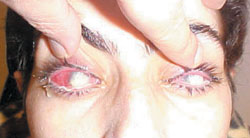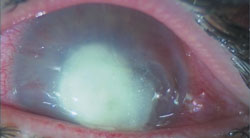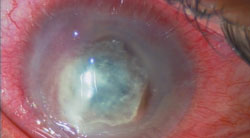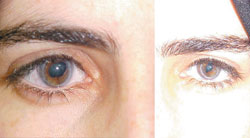Infectious keratitis a potential threat with cosmetic contact lenses
Because the lenses do not require a prescription, consumers may not be aware of risks or receive proper instruction in handling or disinfection.
Click Here to Manage Email Alerts
BORDEAUX – Nonprescription cosmetic soft contact lenses have become a popular optical fashion particularly among teenagers, but without proper care the lenses may be responsible for severe ocular complications, including infectious keratitis.
Most of the problems stem from the fact that cosmetic lenses are not classified as medical devices, do not need a prescription and might be sold in nonprofessional shops, said Joseph Colin, MD.
“Buyers are often not aware of the risks involved in using these lenses without taking the necessary hygienic precautions before, during and after wearing them. Teenagers in particular might get into the habit of sharing their lenses with friends, not fully understanding the risk of transmitting eye infections,” he said.
A recent case
Prof. Colin, along with Farida Aitali and Florence Malet, of Bordeaux University Hospital, and Jamel Feki, of Sfax University Hospital, Tunisia, recently treated a 20-year-old female patient referred for severe bilateral infectious keratitis. She had been wearing cosmetic contact lenses for 1 month when she developed a bilateral ulcer. She had not been informed of any specific hygiene regimen, and just rinsed her lenses with saline solution.
Before she presented to his office, a corneal scrape had revealed the presence of Acanthamoeba and Fusarium solani in both eyes. She had been treated with topical ketoconazole, hexamidine and neomycin eyedrops every hour and with systemic ofloxacin and fosfomycin.
Upon examination, the patient showed a bilateral pre-perforated central stromal keratitis, Prof. Colin said. The topical treatment was changed to fortified antibiotics (vancomycin 50 mg/mL and ceftazidime), polyhexamethylene biguanide and amphotericin B, 1 drop every hour. “Unfortunately, for corneal perforation we had no choice but to perform bilateral keratoplasty,” he said.
One month later, visual acuity was 20/100 in both eyes. Three months later bilateral phacoemulsification was performed because of dense cataract and severe visual loss. One week after surgery, best corrected visual acuity was 20/30 in the right eye and 20/33 in the left eye.
|
|
|
|
|
|
Medical supervision
Acanthamoeba keratitis is a severe infection that rarely responds to antibiotic treatment and potentially leads to blindness, Prof. Colin said. Most cases of the infection occur in contact lens wearers when insufficient precautions are taken with storing, cleaning and disinfecting the lenses, he said.
“This type of bilateral keratitis is relatively rare, but infectious keratitis is a threat for the contact lens wearer. The popularity of cosmetic contact lenses might increase the incidence of this and similar complications in the future,” he said.
He emphasized the importance of buying and using these lenses under medical supervision.
“Cosmetic contact lenses should be prescribed by ophthalmologists, who will provide all the information about their potential sight-threatening complications and teach how to fit, disinfect and handle them. Lack of information and lack of hygiene are the two most prominent lens-related dangers,” he said.
For Your Information:
- Joseph Colin, MD, can be reached at Hôpital Pellegrin, Place Amélie Raba-Lèon, 33076 Bordeaux, France; +33-5-56795608; fax: +33-5-56795909; e-mail: joseph.colin@chu-bordeaux.fr.
- Michela Cimberle is an OSN Correspondent based in Asolo, Italy.




